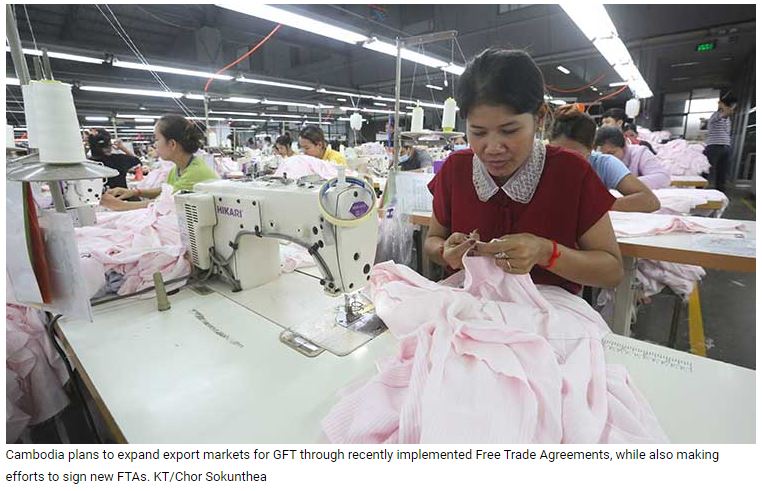Cambodia set to explore new markets for GFT
Cambodia will expand its garment, footwear and travel goods (GFT) export market to more countries in its bid to remain competitive in the industry, especially in the wake of challenges from the European Union (EU) market, under a new policy directive for the sector.
The country’s GFT Development Strategy 2022-2027, discussed recently during the launch of the GFT Sector Brief, undertaken jointly by the European Chamber of Commerce in Cambodia (EuroCham), Textile, Apparel, Footwear & Travel Goods Association in Cambodia (TAFTAC), and Internal Labour Organization (ILO), clearly points to this direction.
Huot Pum, Under Secretary of State, Ministry of Economy and Finance, said at the event that the new strategy proposes market diversification as a key along with other objectives such as promoting investment in high value-added and high-end products, strengthening human resources and improving the conditions of the workers, for keeping the GFT sector competitive and sustainable.
The Sector Brief pointed out that GFT exports to the EU, one of the country’s traditional export markets, dropped by 20 percent in 2020, from $4,257 million in 2019 to $3,410 million, and further declined by another 20 percent, to $2,726, in 2021.
The decline in 2021 is mostly attributed to the exit of the UK from the EU bloc. The actual drop in GFT exports to the EU market, subtracting the UK’s withdrawal from the EU, was just 1.26 percent in 2021.
The Sector Brief said that Cambodia was able to overcome some of these challenges by diverting its GFT exports to other markets, particularly the US. Here, the share of exports rose to 43 percent in 2021, up from 37 percent in 2020, thus making the US the largest single market for Cambodia’s GFT exports.
At the same time, the share of Cambodia’s GFT exports to some other markets – outside the US and the EU – also increased to 33 percent in 2021, from just 28 percent in 2020. This development can again be attributed to the ‘Brexit effect.’ If the UK was included in the 2021 comparison, the share of the sector’s exports to the ‘Rest of the World’ markets remains almost the same.
The partial withdrawal of Cambodia’s duty-free and quota-free access to the EU market under the Everything But Arms (EBA) initiative (announced by the EU in August 2020) affected 64 tariff lines concerning the sector.
Of the 64 affected tariff lines, five relate to travel goods, 13 to footwear products and 46 to garment products. Cambodia may still export those affected products to the EU market, but they will be subject to general tariffs applicable to any other member of the World Trade Organization (WTO).
The remaining 80 percent of Cambodia’s exports still have preferential (duty-free, quota-free) access to the EU market. It is also to be noted that from January 1, 2021, Cambodia (and other Developing and Least Developed-Countries) can still enjoy preferential access to the UK market (under the UK Generalized Scheme of Preferences).
Cambodia’s overall GFT exports rose by 15% in 2021, reaching $11.2 billion. They then increased another 25 percent during Q1, 2022 (relative to Q1, 2021). Given the global challenges that occurred during 2020 and 2021, this should be considered a very positive development.
There is still the positive prospect that Cambodia can expand and diversify its export markets by taking advantage of recently implemented Free Trade Agreements (FTAs). This includes the Cambodia-China FTA (CCFTA), the Regional Comprehensive Economic Partnership (RCEP), both of which came into effect in January 2022 and the Cambodia-Korea FTA (CKFTA) which came into effect earlier this month.
With several FTAs signed, Cambodia is now conducting feasibility studies for additional agreements, such as the Cambodia-Japan FTA (CJFTA), the Cambodia-India FTA (CIFTA), and the Cambodia-Bangladesh FTA (CBFTA). If ratified, these are expected to further open opportunities for Cambodia’s GFT sector exports, as well as other export commodities.
Senior economist and Director General of the Institute of China Studies at the Royal Academy of Cambodia, Ky Sereyvath told Khmer Times that diversifying to more markets is also politically significant for the Kingdom.
“It not only creates more bargaining power for Cambodia as a supplier, but the country can also resist political pressures from the EU,” he said.
Source: https://www.khmertimeskh.com/501206796/cambodia-set-to-explore-new-markets-for-gft/


 English
English




